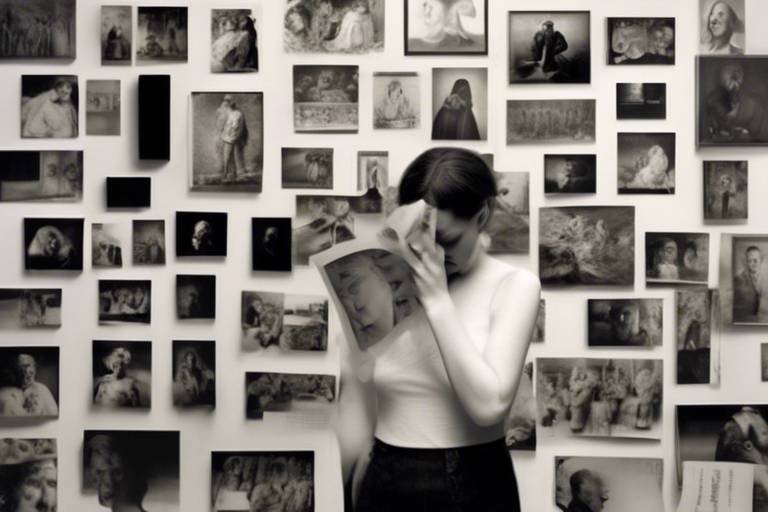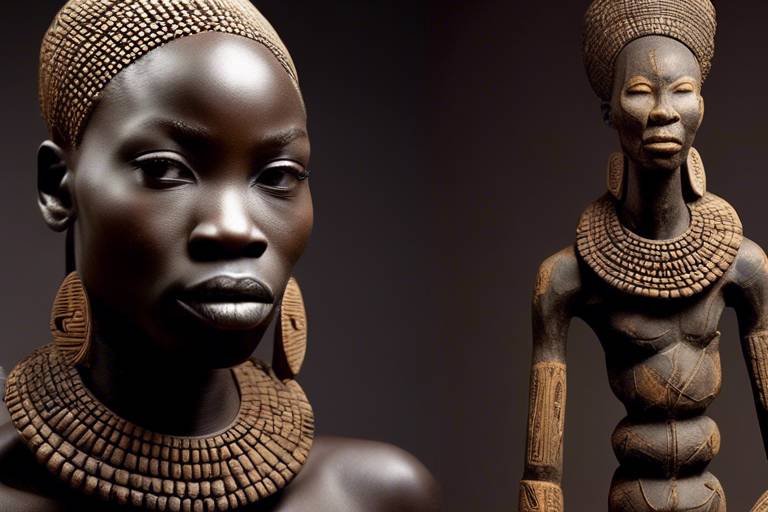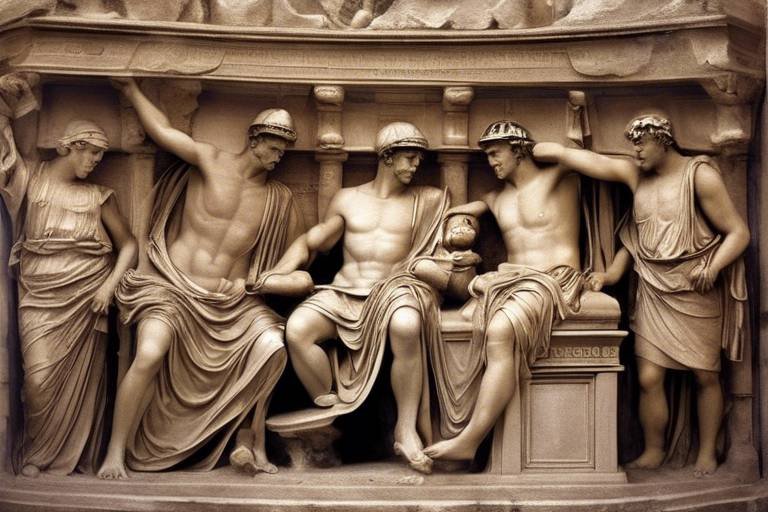The Cultural Heritage of the Ancient Celts
Exploring the rich and diverse cultural legacy left behind by the ancient Celts unveils a world of artistic mastery, linguistic richness, spiritual depth, and societal intricacies. The Celtic civilization, spanning across Europe from the Iron Age to the Roman conquest, has left a profound mark on history, resonating through time with its enigmatic allure.
Within the realm of Celtic art and symbolism, one encounters a tapestry of intricate designs and symbolic motifs that speak volumes about the creativity and craftsmanship of the Celts. From mesmerizing metalwork depicting zoomorphic figures to mesmerizing knot designs symbolizing eternity and interconnectedness, Celtic artistry captivates the imagination and transcends mere aesthetics.
Uncovering the linguistic roots and literary traditions of the Celts reveals a treasure trove of oral narratives, epic tales, and mythological sagas passed down through generations. The Celtic language, with its lyrical cadence and ancient charm, weaves a narrative tapestry that transports listeners to a realm where legends come alive and history melds with myth.
Delving into the realm of Celtic religion and mythology unveils a pantheon of deities, spirits, and sacred beliefs that shaped the spiritual landscape of the ancient Celts. From the revered goddess Brigid, embodying healing and inspiration, to the mighty god Lugh, symbolizing skill and craftsmanship, Celtic mythology offers a glimpse into a world where the divine and mortal realms intertwine.
Understanding the societal organization of the ancient Celts illuminates a culture steeped in tribal traditions, warrior ethos, and a deep reverence for nature. The intricate social structure, with its emphasis on kinship ties, honor codes, and communal rituals, paints a picture of a society where strength, loyalty, and interconnectedness were paramount.
Exploring the seasonal festivals and ritual practices observed by the Celts unveils a profound connection to the cycles of nature, the spirits of the land, and the ancestors who came before. From the vibrant celebrations of Beltane heralding the arrival of summer to the solemn rites of Samhain honoring the spirits of the departed, Celtic festivals are a testament to the enduring bond between humanity and the natural world.
Tracing the lasting impact of Celtic heritage on modern culture reveals a legacy that transcends time and geography, influencing art, music, literature, and spirituality around the globe. The echoes of Celtic artistry, linguistic nuances, mythological themes, and social values resonate in contemporary expressions, enriching the cultural tapestry of the world.
Highlighting significant archaeological discoveries of Celtic settlements, burial sites, and religious centers across Europe sheds light on the material remains of a civilization shrouded in mystery and fascination. The excavation of ancient Celtic artifacts, structures, and inscriptions provides valuable insights into the daily lives, beliefs, and achievements of this enigmatic culture.
Discussing efforts to preserve and protect Celtic cultural heritage underscores the importance of safeguarding the legacy of the ancient Celts for future generations. Museums, educational programs, heritage sites, and ongoing research initiatives play a crucial role in ensuring that the rich tapestry of Celtic civilization endures, inspiring and enlightening present and future seekers of knowledge.

Celtic Art and Symbolism
Exploring the rich and diverse cultural legacy left behind by the ancient Celts, including their art, language, religion, and societal structures.
When delving into the world of Celtic art and symbolism, one is immediately captivated by the intricate and mesmerizing designs that adorn artifacts from this ancient civilization. The Celts were known for their exceptional craftsmanship, especially in metalwork, where they intricately weaved symbolic motifs into their creations. These symbols often carried deep meanings, representing concepts like eternity, interconnectedness, and nature's cycles.
One of the most iconic symbols associated with Celtic art is the endless knot, a design that loops and intertwines without a clear beginning or end, symbolizing the eternal journey of life and the interconnectedness of all things. This symbol, along with others like the triskele and the Celtic cross, showcases the Celts' deep connection to nature and their spiritual beliefs.
Furthermore, Celtic art was not just decorative but also functional, with objects like torcs and brooches serving as both adornments and symbols of status and identity. The intricate patterns and designs found in Celtic art continue to inspire artists and designers to this day, showcasing the timeless beauty and depth of this ancient culture's artistic expressions.

Celtic Language and Literature
The Celtic people had a rich linguistic tradition that has greatly influenced modern languages. Their language, known as Celtic, was spoken by various tribes across Europe, with distinct regional variations. The Celts had a strong oral tradition, passing down stories, myths, and legends through generations. These epic tales were often recited by bards and storytellers, keeping the Celtic culture alive through the power of words.
One of the most famous examples of Celtic literature is the Táin Bó Cúailnge, also known as the Cattle Raid of Cooley, an epic tale of war and heroism from Irish mythology. This story, along with other Celtic myths, reflects the values and beliefs of the ancient Celts, providing insight into their worldview and spiritual practices.
Additionally, Celtic languages have left their mark on modern English and other languages spoken today. Words like "banshee," "slogan," and "brogue" have Celtic origins, showcasing the enduring legacy of Celtic linguistic influence. The intricate knotwork and symbolic designs found in Celtic art are also reflected in their written language, with elaborate scripts and calligraphy adorning ancient manuscripts.
The preservation of Celtic literature is crucial in understanding the cultural heritage of the Celts. Efforts to translate and transcribe ancient Celtic texts have provided valuable insights into their society, beliefs, and traditions. Museums and educational institutions play a vital role in safeguarding these literary treasures for future generations to appreciate and study.

Celtic Religion and Mythology
When delving into the world of Celtic religion and mythology, one cannot help but be captivated by the intricate tapestry of spiritual beliefs and legendary tales woven by the ancient Celts. At the heart of Celtic mythology are a myriad of deities, each embodying different aspects of nature, fertility, and warfare. One of the most revered goddesses in Celtic mythology is Brigid, the triple goddess of fire, poetry, and healing. She symbolizes the enduring presence of femininity and creativity in Celtic culture.
Another prominent figure in Celtic mythology is Lugh, the god of skill and craftsmanship. Often depicted as a master of all trades, Lugh represents the multifaceted nature of the Celtic people, who valued expertise in various domains. His association with the sun and light underscores the importance of illumination and enlightenment in Celtic spirituality.
Central to Celtic religious practices were rituals and ceremonies that honored the cycles of nature and the changing seasons. The Celts celebrated a number of festivals, such as Imbolc, Beltane, Lughnasadh, and Samhain, each marking significant points in the agricultural calendar and spiritual landscape. These festivals were not only occasions for feasting and merriment but also served as opportunities for communal bonding and reverence for the natural world.
The concept of the Otherworld, a mystical realm existing parallel to our own, was a fundamental aspect of Celtic belief. It was believed that the spirits of the dead resided in this ethereal realm, and communication with the Otherworld was facilitated through rituals and divination practices. The veil between the worlds was said to be thinnest during Samhain, the Celtic festival that later evolved into Halloween.
Mythological stories passed down through generations served not only as entertainment but also as moral teachings and cultural touchstones. Tales of heroic deeds, epic battles, and supernatural beings populated the rich tapestry of Celtic folklore, providing insight into the values and beliefs of the ancient Celts. These stories continue to resonate in modern culture, inspiring works of art, literature, and music that pay homage to the enduring legacy of Celtic mythology.

Celtic Social Structure
When delving into the intricate tapestry of Celtic society, one cannot help but be captivated by the unique social structure that defined the ancient Celts. At the heart of their civilization lay a complex tribal system characterized by a deep sense of kinship and loyalty. Each tribe was led by a chieftain, a figure of authority who commanded respect and guided the community through both times of peace and conflict.
Central to Celtic social structure was the revered status of warriors, who were not only skilled in battle but also held in high esteem for their courage and honor. Warriors played a crucial role in protecting their tribes and upholding the values of bravery and loyalty that were deeply ingrained in Celtic culture.
Furthermore, the role of women in Celtic society was far from passive. In contrast to many other ancient civilizations, Celtic women enjoyed a level of freedom and influence that was remarkable for the time. They could inherit property, engage in trade, and even lead their tribes in times of need.
Within this intricate social framework, the concept of honor held great significance. Honor was not merely a personal trait but a communal value that bound the Celtic people together. It was through acts of bravery, loyalty, and generosity that individuals earned respect and solidified their place within the tribe.
Moreover, the social structure of the Celts was not rigid but dynamic, adapting to changing circumstances and evolving over time. As tribes interacted with one another through trade, alliances, or conflicts, the boundaries of social hierarchy shifted, reflecting the ever-changing nature of Celtic society.
In essence, the Celtic social structure was a tapestry woven with threads of kinship, honor, and resilience. It was a system that valued community over individuality, where each member played a vital role in the intricate web of relationships that defined Celtic civilization.

Celtic Festivals and Rituals
The were deeply intertwined with the natural world, reflecting the Celts' connection to the cycles of the seasons and the earth. One of the most well-known Celtic festivals is Samhain, celebrated at the end of the harvest season, marking the beginning of winter. During Samhain, the Celts believed that the veil between the living and the dead was thinnest, allowing spirits to roam the earth. Bonfires were lit to ward off evil spirits and offerings were made to honor ancestors.
Another important Celtic festival is Imbolc, held in early February to welcome the first signs of spring. This festival honored the goddess Brigid, associated with fire, healing, and fertility. People would light candles and fires to symbolize the returning light and warmth of the sun, as well as to purify and prepare for the new season.
Beltane was celebrated in May to mark the beginning of summer, focusing on fertility, growth, and the union of the goddess and the god. Bonfires were a central part of the festivities, symbolizing the sun's strength and power to nurture the land. People would dance around the Maypole, a symbol of fertility and abundance, weaving ribbons as a communal celebration of life.
One of the most significant Celtic festivals was Lughnasadh, held in August to celebrate the first harvest and honor the god Lugh. This festival included games, feasting, and rituals to give thanks for the abundance of the land. It was a time of community gathering, competitions, and storytelling to commemorate the cycle of planting, growth, and harvest.
Throughout the year, the Celts also observed seasonal transitions such as the equinoxes and solstices, marking the balance of light and dark, and the changing of the seasons. These transitions were seen as pivotal moments in the natural cycle, reflecting the interconnectedness of all life and the eternal rhythms of the earth.

Celtic Influence on Modern Culture
When it comes to the , it's fascinating to see how the legacy of the ancient Celts continues to shape various aspects of contemporary society. From art to music, literature to spiritual practices, the imprint of Celtic heritage can be found in unexpected places around the globe.
One of the most prominent areas where the Celtic influence is noticeable is in contemporary art. Many artists today draw inspiration from Celtic motifs and designs, incorporating intricate knotwork and symbolic imagery into their work. This connection to the past adds a layer of depth and meaning to modern artistic expressions.
In the realm of music, Celtic influences are unmistakable. Traditional Celtic music, with its haunting melodies and rhythmic patterns, has not only endured through the centuries but has also influenced modern genres. Elements of Celtic music can be heard in folk, rock, and even electronic music, showcasing the enduring appeal of Celtic musical traditions.
When it comes to literature, Celtic storytelling traditions continue to captivate audiences. The epic tales and mythological stories passed down by the Celts have inspired countless authors and storytellers. Themes of heroism, magic, and adventure resonate across time, bridging the gap between ancient myth and modern fiction.
Another area where the Celtic influence shines through is in spiritual practices. Many people today are drawn to the spiritual beliefs and practices of the ancient Celts, finding resonance in the reverence for nature, the cycles of life, and the interconnectedness of all things. Modern paganism and nature-based spiritualities often draw on Celtic traditions, honoring the wisdom of the past in a contemporary context.
Overall, the Celtic influence on modern culture is a testament to the enduring power of heritage and tradition. By weaving threads of the past into the fabric of the present, we honor the legacy of the ancient Celts and keep their vibrant spirit alive in our modern world.

Celtic Archaeological Sites
When it comes to exploring the ancient Celts, one cannot overlook the fascinating archaeological sites that provide a glimpse into their mysterious world. These sites, scattered across Europe, hold invaluable clues about the daily lives, beliefs, and customs of the Celtic people. From elaborate hillforts to intricate burial mounds, each site tells a unique story of a civilization shrouded in history.
One of the most renowned Celtic archaeological sites is the Hill of Tara in Ireland, often referred to as the ancient capital of the High Kings. This sacred site is steeped in myth and legend, with its iconic Lia Fáil stone and remnants of ancient structures drawing visitors from around the globe. The Hill of Tara stands as a testament to the political and spiritual significance of the Celts in ancient times.
Another notable Celtic archaeological site is the Oppidum of Manching in Germany, a sprawling settlement that once thrived as a bustling hub of trade and craftsmanship. Excavations at Manching have revealed intricate metalwork, elaborate pottery, and evidence of sophisticated urban planning, shedding light on the advanced skills and organization of the Celtic society.
Delving deeper into Celtic history, the Carn Euny Ancient Village in Cornwall, England, offers a glimpse into the everyday life of the Celts. This well-preserved village features stone houses, underground passages, and ritual structures, providing archaeologists with valuable insights into domestic activities, social interactions, and spiritual practices of the ancient Celts.
One cannot discuss Celtic archaeological sites without mentioning the Bibracte Oppidum in France, a significant center of Celtic power and culture during the Iron Age. Excavations at Bibracte have unearthed a wealth of artifacts, including coins, weapons, and religious objects, painting a vivid picture of the economic, military, and religious aspects of Celtic society.
As archaeologists continue to uncover new discoveries and unravel the mysteries of the ancient Celts, these archaeological sites serve as windows into a world long gone but never forgotten. Each artifact, structure, and inscription unearthed adds another piece to the intricate puzzle of Celtic heritage, ensuring that their legacy endures for generations to come.

Preservation of Celtic Heritage
Preservation of Celtic heritage is a paramount task in ensuring that the rich cultural legacy of the ancient Celts is safeguarded for future generations. Efforts to protect and promote Celtic heritage encompass a wide range of initiatives, from the establishment of museums dedicated to Celtic artifacts to educational programs aimed at raising awareness about Celtic history and traditions.
One of the primary ways in which Celtic heritage is preserved is through the conservation of archaeological sites that provide valuable insights into the daily lives and beliefs of the Celts. These sites, ranging from ancient settlements to burial grounds, serve as windows into the past, allowing us to piece together the puzzle of Celtic civilization.
Furthermore, the development of heritage sites dedicated to the Celts plays a crucial role in maintaining and celebrating their cultural heritage. These sites not only showcase artifacts and exhibits related to Celtic history but also provide immersive experiences that transport visitors back in time to the world of the ancient Celts.
Education also plays a vital role in the preservation of Celtic heritage, with schools and universities offering courses on Celtic language, art, and history. By educating the public about the significance of Celtic culture, these programs help ensure that the legacy of the Celts remains alive and relevant in the modern world.
In addition to physical preservation efforts, digital initiatives have also emerged as valuable tools for safeguarding Celtic heritage. Online archives, virtual exhibitions, and interactive platforms provide accessible resources for learning about Celtic history and engaging with Celtic artifacts, reaching a global audience and fostering interest in Celtic culture.
Frequently Asked Questions
- What is Celtic art known for?
Celtic art is renowned for its intricate designs, particularly in metalwork and jewelry. The use of intricate knotwork and symbolic motifs are characteristic of Celtic artistic expression.
- Are there any surviving Celtic languages?
Yes, there are surviving Celtic languages such as Irish, Welsh, Scottish Gaelic, and Breton. These languages have deep historical roots and are still spoken by communities today.
- Who were some important Celtic deities?
Some important Celtic deities include Brigid, the goddess of healing and poetry, and Lugh, the god of craftsmanship and skill. These deities played significant roles in Celtic mythology and religious practices.
- What were Celtic festivals like?
Celtic festivals were often tied to the cycles of nature and celebrated seasonal changes. These festivals involved rituals to honor the harvest, solstices, and other significant events in the Celtic calendar.
- How has Celtic culture influenced modern society?
Celtic culture has had a lasting impact on modern art, music, literature, and spiritual practices. Elements of Celtic art and mythology can be seen in contemporary works, showcasing the enduring legacy of the ancient Celts.



















